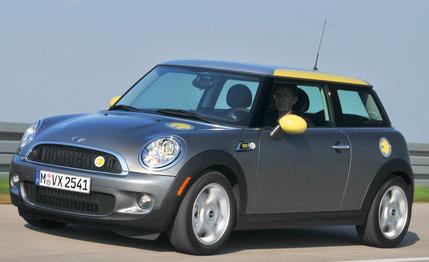 First Drive Review
First Drive Review
Mini has recently touted its “carfun” footprint in its ads. Now, in an effort to reduce its carbon footprint, the company is building a fleet of approximately 500 plug-in electric vehicles that will be made available to select companies and individuals in California, New York, and New Jersey by early 2009.
The heart of the vehicle is its lithium-ion battery, a three-element power source made of 5088 cells that are linked together with a combination of series and parallel connections. With a maximum capacity of 38 kilowatt-hours—28 of which are usable—the Mini E can go 150 miles on a full charge, which works out to 0.19 kWh per mile. At today’s energy prices, that’s less than three cents per mile, or just pennies on the dollar compared with fossil-fuel costs.
How to Make a Mini Even Less Practical
The battery is situated where the rear passengers normally would go, making this a two-seat affair. The power-storage unit weighs 573 pounds, which accounts for the bulk of the vehicle’s added poundage. (The Mini E weighs 3230 pounds compared with an automatic-equipped Mini Cooper’s 2634.) Mini says the vehicle’s batteries can be recharged from any wall plug, with the quickest full charge coming from the included wall box. This will be installed in the customer’s (lockable) garage and can step up normal amperage to charge the vehicle in two-and-a-half hours.
Power is fed to a transversely mounted electric motor that turns the front wheels. Output is rated at 204 hp and 162 lb-ft of torque, the latter of which is completely available from a standstill. The Mini E uses a single-speed transmission adapted from the Cooper S’s automatic. Top speed is 95 mph, and 60 mph comes from a stop in 8.5 seconds, which happens to match Mini’s claimed time for a manual-equipped Cooper. All of this with zero tailpipe emissions (since there’s no tailpipe)—but it’s important to remember that the electricity still has to come from somewhere, and in the U.S. there’s a good chance that it’s a coal-fired plant.
After driving the Mini E around downtown L.A. shortly after its Los Angeles auto show debut, we came away conflicted. As an electric car, it’s great. But swapping the gas motor for an electric powertrain simply drains the Mini of its motoring mojo. Because of the added weight and revised rear suspension, the driving experience is markedly different from that of the rest of Mini’s lineup. The visceral, organic quality that makes the Mini such a joy is gone, and in spite of the fact that weight distribution is now an even 50/50 front to rear, compared with 60/40 for the Cooper hatchback, the E feels quite weighty in corners, and its skinny little tires don’t help much in the grip department. The electric motor propels the car quickly enough to squirt about in traffic, but as is characteristic of most electrics, this one exhibits the same level of warmth and perkiness as Dick Cheney. The most disconcerting aspect of the electric Mini, however, is the deafening silence with which it gathers speed. Seriously, a Mini that emits no sound is as profound a letdown as a skinny mall Santa or a football game without cheerleaders.